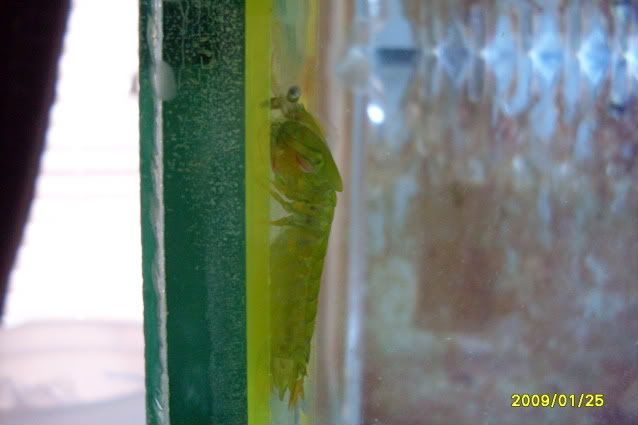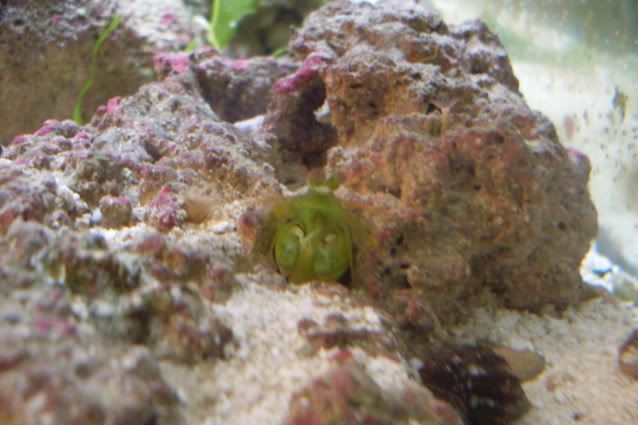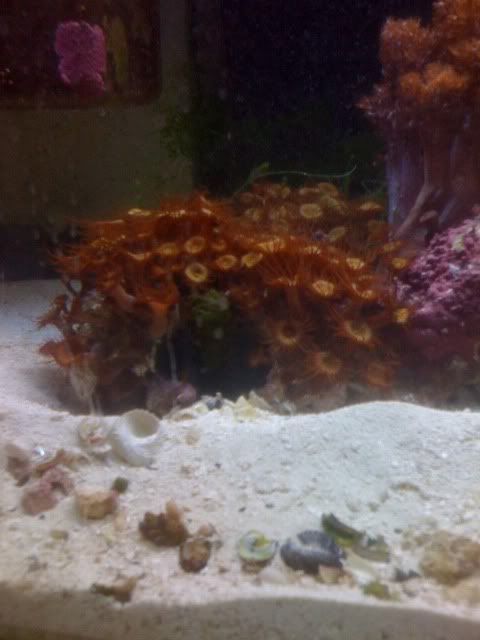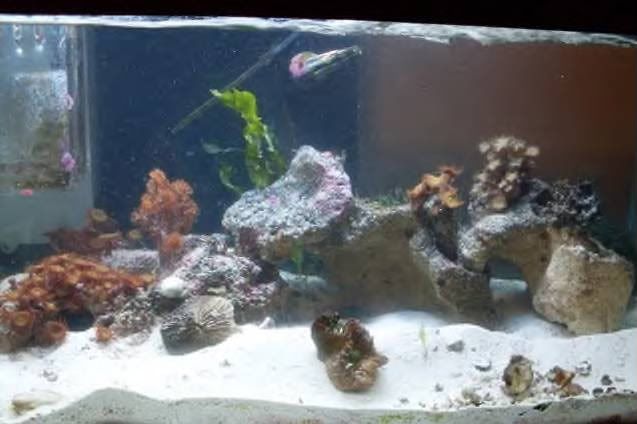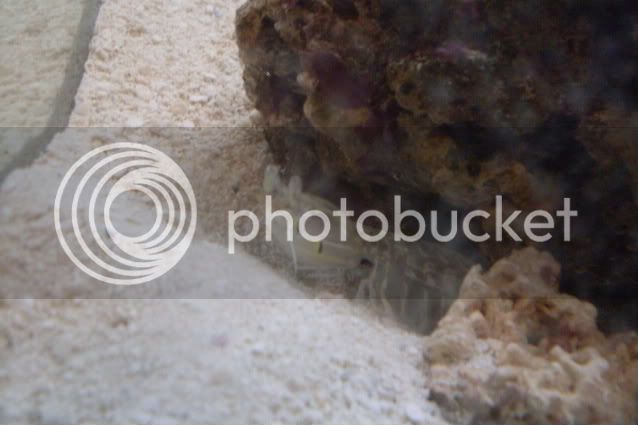Koshmar
Member
- Joined
- Jan 12, 2011
- Messages
- 21
- Reaction score
- 0
I've got some time between classes right now and I thought I'd post some basic info on these little creatures. In my introduction I stated that I migrated over from mantis shrimp to praying mantids and I got some questions/responses about these guys. So here it goes for those of you who are interested in keeping these guys or just want to better understand them.
Mantis shrimp (Stomatopods) are a group of crustaceans which ARE NOT SHRIMP. They are very distantly related to shrimp and have a fossil record dating back to 400 million years! With some 500 different species these guys are very diverse and special in terms of their abilities. There are three functional "types" which they can be grouped in for the average hobbiest. The first two types are well known: Spearers/Slashers and Smashers, the third type most people don't know about is the hatchet type. These types are based on how they capture their prey (raptorial appendages).
In the aquarium hobby, most people consider these little guys satin incarnate and are feared "pests" with ridiculous stories surrounding them. As with most animals with reputations, these guys are poorly understood by most hobbiests.
Common Untrue Myths About Mantis Shrimp
1. Their strike has the force of a .22 calibur bullet!
Very common phrase I see on youtube comments. SOME species have the ability to strike at ROUGHLY the acceleration of a .22 calibur bullet. What does that mean? It's too fast for your eyes to catch, you only see a blur if your lucky but it's not the equivalent of being shot by any means. Being hit by most hitch-hiking species feels like being hit by a rubber band snap (unless they have their dactyls unfolded! More on that later). So no, they can't break your fingers, or my favorite claim "rip you fingers clean off".
2. They'll kill all your fish!
Yes, they can kill fish but they go first for easy prey (snails, crabs, slow bottom dwelling animals). Most of the time fish are left alone, in fact most mantis shrimp keepers keep damsels with their pets without too many problems. Your fish are safe if the mantis is well fed and small. Most of the time they bolt when they see humans or large fish.
3. Dude, they can shatter glass!
Approximately three species can "crack" glass but they have to get around or over four inches. The glass must be standard ten gallon thick glass and it has to be hit just right. Only one of the three is a hitch-hiker (G. chiragra) and you'll know if you have that bad boy in your tank. They'll only hit glass if aggitated or burrowing to the bottom. Side panels are rarely hit. In other words, you only have to be concerned if you have a small tank and one of three specific species. ("peacock", G. chiragra, O. japonicus)
4. Peacock Mantis Shrimp For SALE!
If it doesn't look like every photo of a peacock you've ever seen, it's NOT a peacock. THEY DON'T CHANGE COLORS after a molt to magically look like a peacock just because it's small. Don't fall for this when buying one. Even juveniles look like adults in terms of coloration. Also, no one captively breeds this species, only three species have ever been bred in captivity and those were in labs with low yield rates by people with Ph.D's. Don't fall for that either, most lfs owners know very little about mantis shrimp.
Cool Facts That Are True
1. They have the most complex eyes in the animal kingdom. 16 photoreceptors, hexnocular vison, ability to see polarized light, UV, IR, and a huge range of visual spectrum colors.
2. Some species communicate via flourescence.
3. They can remember individuals of the same species for up to around two weeks.
4. They have the second fastest strike in the world.
5. They use their telsons as sheilds when fighting.
6. The species L. maculata can burrow deep enough to avoid being detected by sharks.
Keeping Stomatopods
I'll keep this relatively brief unless I get responses to elaborate. Mantis shrimp are easy to keep. They are a great starting animal for a new hobbiest. Just have a general knowledge of marine aquariums and do your basic research (nitrogen cycle, lighting, water chemistry, ect...). NO COPPER! Copper kills stomatopods even in minute portions. Don't use volatile organic solvents around their tank (lysol, floor wax) You can keep corals with stomatopods just make sure they are firmly attached since they love to decorate. Tank size depends on species but most hitch-hikers can be kept in five-ten gallons and up (N. wennerae, G. smithii, G. chirgra*). Peacocks do best in thirty gallons or forty gallon breeders, you can get away with a 20 long though. P. ciliata do best in 20 longs. Foot print is key, get a longer tank not a higher one. (I've used 20 longs exclusively with great results). You cannot keep two mantids in the same tank unless you have a mated pair of L. maculatas (good luck finding a female). All hitch-hikers will be smashers and no, peacocks are no hitch-hikers. For smashers you need a decent sized rock and coral rubble to build a burrow. Place the big rock on the glass then fill with sand to stabilize the rock. Temp at 75-80 with most species. Standard salinity (most species are very tolerant). I've had a poweroutage where all my mantis shrimp survived in 85 degree water in the summer. Filters can be HOB, cycled LR only, sumps, basically whatever except for undergravel filters (very outdated anyway). Skimmers are great but not needed. As with most animals, keep nitrates below 20. Smashers require at least one hard shelled prey item a month (snail, crab, clam, ect..) Feed 2-3 times a week with meaty food (silversides, mysid, squid, brine, clam, krill). They due best with standard flourescent lighting or ambient. Check where your species came from for depth, one example is peacocks don't do well under T5s or halides because they are prone to shell rot. If you have a spearer (P. ciliata, L. maculata, S. rugosa), feed 2-3 times a week with soft meaty food (shimp are best). Vary the diet as much as possible. Selcon is a great nutrient additive but is not required. Mantis shrimp live on average 5-6 years depending on the species. L. maculata can live over 20 years, so know what you're getting into before you buy. For species identification and specific requirements visit this site or Reef Central's mantis shrimp forum:
http://www.ucmp.berkeley.edu/arthropoda/crustacea/malacostraca/eumalacostraca/royslist/
Mantis shrimp can injure you! Don't put your hands near their burrow or try to hand feed (even though its really fun teeeheee). Most of the time if you get hit it will feel like a rubber band snap but ALL mantis shrimp have this portion of their raptorial appendages called a dactyl. Its basically a sharp knife that can unfold and stab you. Yeah....you'll bleed a lot and the injury can become infected.
These are Dactyls. Don't get hit by them....
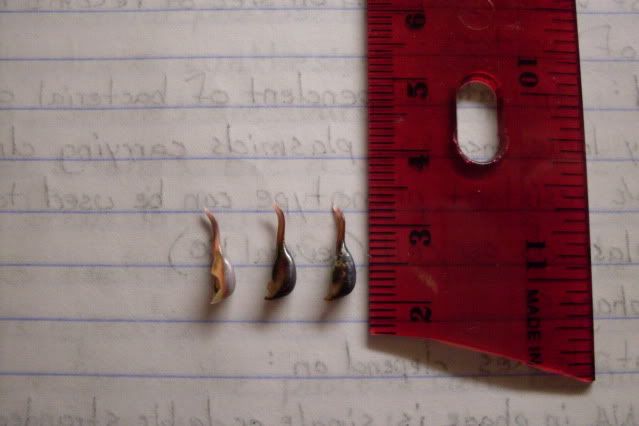
Most of the time when you stick your hands in the tank they will cautiously investigate or bolt to their burrow until they get use to you and associate you with food. Some species are very interactive and fun to "play" with (peacocks, N. wennerae, G. smithii, O. japonicus). Just use the same principle as you would with a lionfish when dealing with them, know where they are and give them space. Very rewarding, very cool. This is by no means a complete write up on taking care of them, I left a lot of specifics out but this is getting fairly long. If you have any questions, you can P.M. me or visit Reef Central. Dr. Roy Caldwell Gonodactylus(Our Stomatopod King) frequents the forum quite often and much of my knowledge has come from conversations with him and my own first hand experience. I hope this helps if you are interested in these cool creatures.
Mantis shrimp (Stomatopods) are a group of crustaceans which ARE NOT SHRIMP. They are very distantly related to shrimp and have a fossil record dating back to 400 million years! With some 500 different species these guys are very diverse and special in terms of their abilities. There are three functional "types" which they can be grouped in for the average hobbiest. The first two types are well known: Spearers/Slashers and Smashers, the third type most people don't know about is the hatchet type. These types are based on how they capture their prey (raptorial appendages).
In the aquarium hobby, most people consider these little guys satin incarnate and are feared "pests" with ridiculous stories surrounding them. As with most animals with reputations, these guys are poorly understood by most hobbiests.
Common Untrue Myths About Mantis Shrimp
1. Their strike has the force of a .22 calibur bullet!
Very common phrase I see on youtube comments. SOME species have the ability to strike at ROUGHLY the acceleration of a .22 calibur bullet. What does that mean? It's too fast for your eyes to catch, you only see a blur if your lucky but it's not the equivalent of being shot by any means. Being hit by most hitch-hiking species feels like being hit by a rubber band snap (unless they have their dactyls unfolded! More on that later). So no, they can't break your fingers, or my favorite claim "rip you fingers clean off".
2. They'll kill all your fish!
Yes, they can kill fish but they go first for easy prey (snails, crabs, slow bottom dwelling animals). Most of the time fish are left alone, in fact most mantis shrimp keepers keep damsels with their pets without too many problems. Your fish are safe if the mantis is well fed and small. Most of the time they bolt when they see humans or large fish.
3. Dude, they can shatter glass!
Approximately three species can "crack" glass but they have to get around or over four inches. The glass must be standard ten gallon thick glass and it has to be hit just right. Only one of the three is a hitch-hiker (G. chiragra) and you'll know if you have that bad boy in your tank. They'll only hit glass if aggitated or burrowing to the bottom. Side panels are rarely hit. In other words, you only have to be concerned if you have a small tank and one of three specific species. ("peacock", G. chiragra, O. japonicus)
4. Peacock Mantis Shrimp For SALE!
If it doesn't look like every photo of a peacock you've ever seen, it's NOT a peacock. THEY DON'T CHANGE COLORS after a molt to magically look like a peacock just because it's small. Don't fall for this when buying one. Even juveniles look like adults in terms of coloration. Also, no one captively breeds this species, only three species have ever been bred in captivity and those were in labs with low yield rates by people with Ph.D's. Don't fall for that either, most lfs owners know very little about mantis shrimp.
Cool Facts That Are True
1. They have the most complex eyes in the animal kingdom. 16 photoreceptors, hexnocular vison, ability to see polarized light, UV, IR, and a huge range of visual spectrum colors.
2. Some species communicate via flourescence.
3. They can remember individuals of the same species for up to around two weeks.
4. They have the second fastest strike in the world.
5. They use their telsons as sheilds when fighting.
6. The species L. maculata can burrow deep enough to avoid being detected by sharks.
Keeping Stomatopods
I'll keep this relatively brief unless I get responses to elaborate. Mantis shrimp are easy to keep. They are a great starting animal for a new hobbiest. Just have a general knowledge of marine aquariums and do your basic research (nitrogen cycle, lighting, water chemistry, ect...). NO COPPER! Copper kills stomatopods even in minute portions. Don't use volatile organic solvents around their tank (lysol, floor wax) You can keep corals with stomatopods just make sure they are firmly attached since they love to decorate. Tank size depends on species but most hitch-hikers can be kept in five-ten gallons and up (N. wennerae, G. smithii, G. chirgra*). Peacocks do best in thirty gallons or forty gallon breeders, you can get away with a 20 long though. P. ciliata do best in 20 longs. Foot print is key, get a longer tank not a higher one. (I've used 20 longs exclusively with great results). You cannot keep two mantids in the same tank unless you have a mated pair of L. maculatas (good luck finding a female). All hitch-hikers will be smashers and no, peacocks are no hitch-hikers. For smashers you need a decent sized rock and coral rubble to build a burrow. Place the big rock on the glass then fill with sand to stabilize the rock. Temp at 75-80 with most species. Standard salinity (most species are very tolerant). I've had a poweroutage where all my mantis shrimp survived in 85 degree water in the summer. Filters can be HOB, cycled LR only, sumps, basically whatever except for undergravel filters (very outdated anyway). Skimmers are great but not needed. As with most animals, keep nitrates below 20. Smashers require at least one hard shelled prey item a month (snail, crab, clam, ect..) Feed 2-3 times a week with meaty food (silversides, mysid, squid, brine, clam, krill). They due best with standard flourescent lighting or ambient. Check where your species came from for depth, one example is peacocks don't do well under T5s or halides because they are prone to shell rot. If you have a spearer (P. ciliata, L. maculata, S. rugosa), feed 2-3 times a week with soft meaty food (shimp are best). Vary the diet as much as possible. Selcon is a great nutrient additive but is not required. Mantis shrimp live on average 5-6 years depending on the species. L. maculata can live over 20 years, so know what you're getting into before you buy. For species identification and specific requirements visit this site or Reef Central's mantis shrimp forum:
http://www.ucmp.berkeley.edu/arthropoda/crustacea/malacostraca/eumalacostraca/royslist/
Mantis shrimp can injure you! Don't put your hands near their burrow or try to hand feed (even though its really fun teeeheee). Most of the time if you get hit it will feel like a rubber band snap but ALL mantis shrimp have this portion of their raptorial appendages called a dactyl. Its basically a sharp knife that can unfold and stab you. Yeah....you'll bleed a lot and the injury can become infected.
These are Dactyls. Don't get hit by them....

Most of the time when you stick your hands in the tank they will cautiously investigate or bolt to their burrow until they get use to you and associate you with food. Some species are very interactive and fun to "play" with (peacocks, N. wennerae, G. smithii, O. japonicus). Just use the same principle as you would with a lionfish when dealing with them, know where they are and give them space. Very rewarding, very cool. This is by no means a complete write up on taking care of them, I left a lot of specifics out but this is getting fairly long. If you have any questions, you can P.M. me or visit Reef Central. Dr. Roy Caldwell Gonodactylus(Our Stomatopod King) frequents the forum quite often and much of my knowledge has come from conversations with him and my own first hand experience. I hope this helps if you are interested in these cool creatures.





